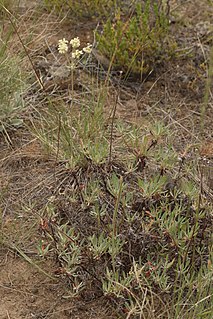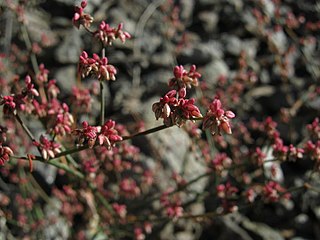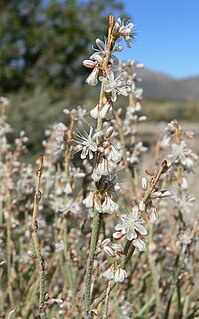
Eriogonum nudum is a perennial shrub of the wild buckwheat genus which is known by the common name naked buckwheat or nude buckwheat.

Eriogonum cinereum is a species of wild buckwheat known by the common names coastal buckwheat and ashyleaf buckwheat.

Eriogonum lobbii is a species of wild buckwheat known by the common name Lobb's buckwheat or prostrate buckwheat. It is native to most of the mountain ranges of northern California and their extensions into Oregon and Nevada. It is found in a number of mountain plant communities.

Eriogonum strictum is a species of wild buckwheat known by the common name Blue Mountain buckwheat. It is a common plant of western North America from northern California to British Columbia where it is found along rocky slopes and scrubland. It flowers early in the summer.

Eriogonum umbellatum is a species of wild buckwheat known by the common name sulphurflower buckwheat, or simply sulphur flower. It is native to western North America from California to Colorado to central Canada, where it is abundant and found in many habitats, including the sagebrush steppe and alpine areas. It is an extremely variable plant and hard to identify because individuals can look very different from one another. Also, there are many varieties. It may be a perennial herb blooming by summer with stems 10 centimeters tall and two to six clusters of flowers, with a whorl of leaves below the stems, or a sprawling shrub approaching two meters high and wide. The leaves are usually woolly and low on the plant, and the flowers come in many colors from white to bright yellow to purple. Native American groups utilized parts of this plant for a number of medicinal uses.

Eriogonum ursinum is a species of wild buckwheat known by the common names Bear Valley buckwheat and talus buckwheat. It is endemic to northern California where it is found on mountains from the northern Sierra Nevada to the southern Klamath Mountains.

Chorizanthe pungens is a species of flowering plant in the buckwheat family known by the common name Monterey spineflower. It is endemic to California, where it is known from the San Francisco Bay Area south along the Central Coast.

Eriogonum heracleoides is a plant of western North America that has many flowering clusters which are usually cream colored, or off-white. It can usually be found in rocky areas, such as sagebrush deserts and Ponderosa pine forests. Parsnipflower buckwheat is in the genus Eriogonum and the family Polygonaceae, which is a family of plants known as the "knotweed family". It inhabits much of the western part of the United States and southern British Columbia.
Eriogonum apiculatum is a species of wild buckwheat known by the common name San Jacinto buckwheat. It is endemic to California, where it is known from the San Jacinto, Santa Rosa, Palomar, and Cuyamaca Mountains of San Diego and western Riverside Counties. Its habitat includes chaparral and wooded slopes on granite sands. This is an annual herb producing a spreading to erect, glandular stem up to 90 centimeters tall. The oblong leaves appear at the base of the plant. They are hairy and glandular in texture. Most of the stem is made up of the inflorescence, branching, spindly cyme with clusters of flowers at the tips of the branches. The individual flowers are under 3 millimeters wide and are white in color with reddish stripes.
Eriogonum breedlovei is a rare species of wild buckwheat known by the common name Paiute buckwheat. It is endemic to the High Sierra Nevada of California, where its two varieties are uncommon members of the flora in granite and limestone rocky high mountain habitat.

Eriogonum congdonii is a species of wild buckwheat known by the common name Congdon's buckwheat. It is endemic to the Klamath Mountains of northern California, where it is an uncommon member of the serpentine soils flora in the local forests. It is a low, matting shrub growing up to about half a meter wide and tall. The woolly leaves are widely lance-shaped and are found along the stems, especially in clusters at the stem tips. The inflorescence is an erect, dense umbel of many tiny bright yellow flowers.

Eriogonum eremicola is a rare species of wild buckwheat known by the common names Telescope Peak buckwheat and Wild Rose Canyon buckwheat. It is endemic to Inyo County, California, where it is known from only a few occurrences in the Inyo Mountains and Telescope Peak in Death Valley. It grows in sandy to rocky habitat in the forests and woodlands of these desert mountains. It is an annual herb producing a spreading, glandular, reddish green stem up to about 25 centimeters tall. The rounded, woolly leaves are up to about 2.5 centimeters long and are located at the base of the stem. The scattered inflorescences are small clusters of tiny flowers which are white with reddish stripes, aging to solid red, or sometimes yellow. The plant is under protection in Death Valley National Park.

Eriogonum hoffmannii is a species of wild buckwheat known by the common name Hoffmann's buckwheat. It is endemic to Inyo County, California, where it is found only in the mountains around Death Valley; most of the known populations of the plant are located in Death Valley National Park. The plant grows in the desert scrub on the slopes of the Panamint, Black, and Funeral Mountains.

Eriogonum latens is a species of wild buckwheat known by the common name Inyo buckwheat. It is native to the western Great Basin region, in the eastern slopes of the Sierra Nevada and the Inyo Mountains of California and the White Mountains, which extend just into western Nevada. It is an uncommon member of the flora in the sagebrush and woodlands of these mountains, where it grows in granitic sandy soils.

Eriogonum luteolum is a species of wild buckwheat known by the common name goldencarpet buckwheat. It is native to many of the mountain ranges of California and southern Oregon, including the Sierra Nevada, Cascades and California Coast Ranges. It grows in mountain and foothill habitat, such as forest and woodland, on granite and sometimes serpentine soils.

Eriogonum panamintense is a species of wild buckwheat known by the common name Panamint Mountain buckwheat. It is native to several of the desert mountain ranges of eastern California and western Nevada, including the Panamint Range. It grows in various types of mountain ridge habitat, such as sagebrush and coniferous woodland.

Eriogonum parishii is a species of wild buckwheat known by the common name mountainmist.
Eriogonum pendulum is a rare species of wild buckwheat known by the common name Waldo buckwheat. It is endemic to the Klamath Mountains of Josephine County, Oregon, and Del Norte County, California, where it is a member of the serpentine soils flora.

Eriogonum siskiyouense is a rare species of wild buckwheat known by the common name Siskiyou buckwheat.

Eriogonum ternatum is a species of wild buckwheat known by the common name ternate buckwheat. It is native to mountain ranges of northern California and southern Oregon, where it grows in the serpentine soil of the forests. This is a perennial herb forming mats up to half a meter wide with rosetted clusters of oval to rounded woolly leaves each about a centimeter long. The inflorescence arises on a flowering stem and bears an umbel of bright yellow flowers.
















